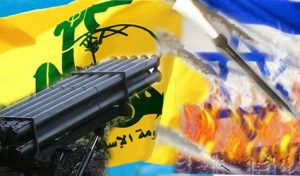The recent Israeli strike in the city of Palmyra that targeted a weapons shipment meant for Hezbollah was the deepest such raid into Syrian territory since the beginning of the Syrian civil war, like reported by ekurd.net.
It clearly indicates that Israel is going to any extend to stop weapons transfer to Hezbollah. But despite all these preventive measures of Jewish state Hezbollah is still able to make itself a most potent threat to Israel. Situated along Israel’s northern border, in Beirut’s suburbs, and throughout the Bekaa Valley, Hezbollah maintains an advanced military arsenal exceeding that of many national armies.
Today Hezbollah is the most powerful military and political force in Lebanon, dominating South Lebanon, and playing a critical role in the Syrian conflict. Currently all of southern Lebanon is a Hezbollah fortress of underground bunkers, rocket launch sites and interconnecting tunnels. While Hezbollah doesn’t have operational air wing of its own but in every other way it can be described as a medium size regular army rather than semi-amateur militia. Moreover Hezbollah now enjoys the full support of Lebanese army. Israeli working assumption is that the Lebanese army will play an active role against Israel in the next war on Lebanon, operating under Hezbollah’s command. Let’s have a look at various factors which have contributed in Hezbollah increased strength.
Acquisition of Modern Rockets/Missiles – Israeli intelligence estimates that Hezbollah now possesses arsenal of some 150,000 missiles and rockets. The group is in possession of tactical ballistic missiles including Scud missiles, Fateh-110 Iranian missiles, and M-600 missiles, a Syrian modified version of the Fateh-110. Many of them covering the whole of Israel. While Hezbollah largely fired unguided rockets into Israel during the 2006 war, its weapons capabilities have allegedly received a major upgrade.
Now the group has the ability to strike guided munitions across Israel, they can hit targets inside Israel including central and southern areas with increased accuracy, including command posts, airfields, and major economic targets. Israeli military planners estimate that Hezbollah will be able to launch thousands of Rockets/Missiles per day in a future conflict, compared to the 2006 rate of one hundred per day. This rate of rocket fire can overwhelm all of the Israeli anti-missile defence systems like- Arrow , David’s Sling and Iron Dome.
Effective Air Defence Systems– Israel Air Force always had the upper hand in all the conflicts it participated just apart from initial phase of 1973 Yom Kippur war. It played very important role in 2006 Lebanon war by destroying Hezbollah’s entire long-range missile capabilities within few hours. But now Hezbollah is in possession of some of the very effective air defence systems which going to prove a big challenge for Israeli Air Force in dominating the Lebanese air space. Hezbollah currently possess SA-17 Buk anti-aircraft missile battery of Russian origin which can directly threaten Israeli aircraft operating in northern Israel and the region.
Valuable experience in Syrian war– In fighting alongside the Syrian government, Hezbollah has gained a lot of tactical battlefield experience and weaponry that has made it a far more threatening force for its enemies elsewhere in the region. Those close to the group say that for the first time Hezbollah has the ability to bring a war with Israel into Israeli territory. Hezbollah improved its logistical operations and learned to use more sophisticated equipment, artillery cover, and reconnaissance and surveillance drones more effectively in the Syrian Conflict.
Ability to open Second Front– Hezbollah has the capability to open a second front at Syrian controlled Golan Heights against Israel in any future confrontation. Hezbollah has good reason to prefer placing its projectiles in Syrian control Golan. This would place those projectiles out of range of IDF ground troops, and could be hidden in the Syrian army’s hardened shelters to better insulate them from air strikes. By dispersing the weapons across the second front in Syria Hezbollah would complicate Israel’s task of replicating that success. Israeli jets would now have to cover a much larger area to locate and destroy these rockets, while also worrying about ducking Syrian and Russian air defenses.
To counter this potent threat to the national security of Israel a comprehensive hybrid strategy is required which include both defensive and offensive measures. Defensively, Israel should try to increase the capacity of its all anti-missile defense systems and strengthen its civil defense measures to reduce the effects of Hezbollah’s rocket/missile offensive. IDF offensive operations should focus on eliminating the threat. This would likely mean destroying launch sites throughout Lebanon and seizing launch areas. Therefore, an offensive strategy should be devised aimed specifically at acquiring territory so as to deny the enemy a platform from which it could launch its weapons. Moreover Gideon Doctrine which suggests to quickly use of full force against the enemy throwing it off the balance and dealing it a crushing blow before it can recover can also be used as an offensive measure.



